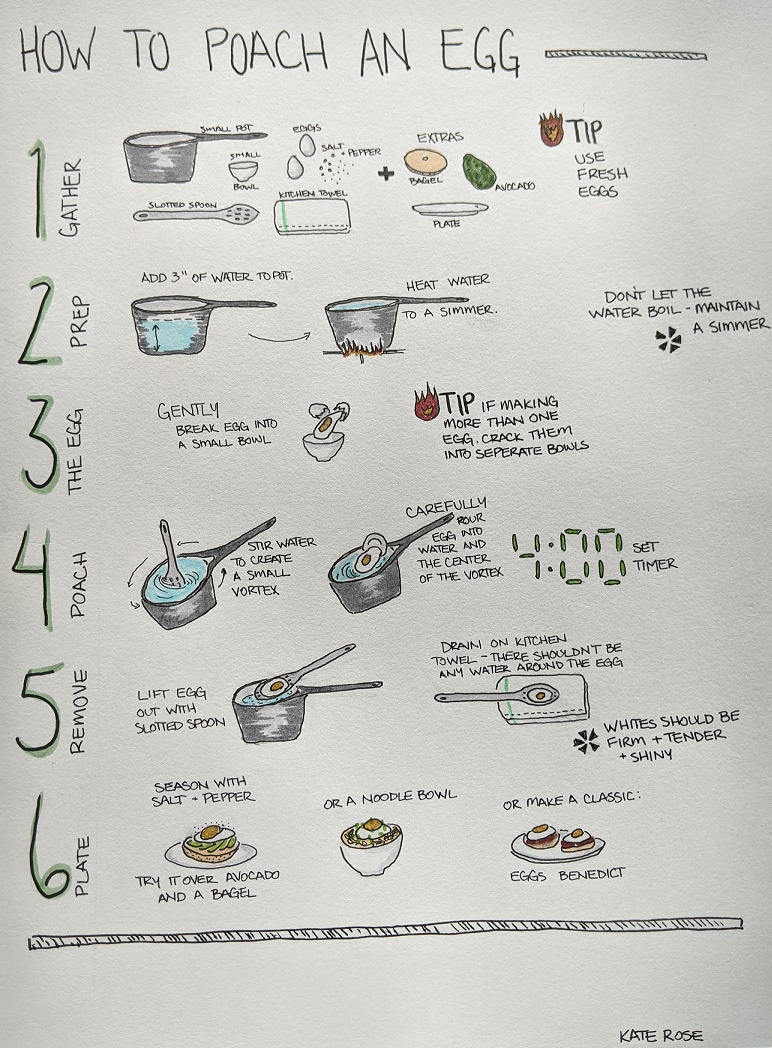How to Perfectly Poach an Egg
While many individuals find preparing a poached egg intimidating, it can be quite easy once familiar with the process. Follow the instructions below for a straightforward approach to poaching eggs.
How to Perfectly Poach an Egg
Start by gathering a small pot, a slotted spoon, a small glass or metal bowl, a clean paper towel, fresh eggs, salt and pepper, a plate and whatever else you’d eat the egg with - I prefer avocado and Montreal-style bagels.
Once all your ingredients and tools have been gathered, add 2-3 inches of water to the small pot and put it onto the stove to bring up to a simmer. While waiting for the water, gently crack an egg into the small bowl and set aside.
As the water comes to a simmer, use the slotted spoon to create a small vortex by stirring counterclockwise. Remove the spoon and carefully lower and tip the egg into the center of the vortex. Set a timer for four minutes.
While the egg cooks ,, use this time to prepare the other components for your egg. When four minutes are up, use the slotted spoon to gently lift the egg out of the water and rest the spoon and egg on the paper towel.
Once the egg is drained, place it with the rest of your dish and season with salt and pepper.
Tip: If preparing multiple poached eggs, it's best to prepare them one at a time. If doing this, have an additional bowl with cold water set aside. Instead of draining the cooked egg, place it in the cold water to stop the cooking. Poach the other eggs and just before serving, place the cooled poached eggs into the remaining hot water to warm before plating (Child, J, et. al., 1999).

Poached Egg Hack
Still feeling overwhelmed about poaching eggs? Try this easy poached egg hack!
4 Creative Ways to Serve Poached Eggs
Spinach Polenta with Mushrooms, Leek and a Poached Egg
This rich Spinach Polenta with Mushrooms, Leek and a Poached Egg dish is perfect for a weekend brunch or weeknight meal. Creamy polenta is elevated with the addition of umami-rich mushrooms. A poached egg on top completes the dish and adds another layer of texture.
Poached Egg Soup
The light, ginger-scented broth compliments the delicately poached eggs perfectly. This Poached Egg Soup is a great first course or easy weeknight meal!
Breakfast Poutine
This Breakfast Poutine is a delicious twist on a classic that will make you forget everything you ever knew about poutine, especially with the addition of maple Hollandaise!
Salade Lyonnaise
Salade Lyonnaise is a classic French salad made with fresh greens, crispy bacon, creamy poached egg and a bold vinaigrette.
FAQs
Can I poach eggs in advance and reheat them later?
Poached eggs can be reheated by placing the cooked eggs in simmering water for 1-2 minutes.
What's the best type of vinegar to use for poaching eggs?
Although vinegar is not needed to poach eggs, adding a touch of white vinegar to the water can help prevent the egg whites from dispersing in the water.
How can I prevent my poached eggs from spreading in the water?
Ensuring your water is only slightly simmering will help keep your eggs together. If you find your eggs are still dispersing, try making a vortex in the water and cracking your egg into the funnel that forms, or add a little bit of vinegar.
Is it necessary to swirl the water when poaching eggs?
Although not necessary, swirling the water to create a small vortex can help prevent the egg whites from dispersing.
Can I poach multiple eggs at once?
To maintain the perfect poached egg shape, we recommend poaching eggs once at a time and placing the eggs to cool in a cold bowl of water. When all of the eggs are poached, combine them back into the hot water and let warm for 1-2 minutes before serving.
How long should I poach eggs for a medium, soft, or hard yolk?
Use the following cooking times to achieve your desired yolk hardness:
- Soft: 3-4 minutes
- Medium: 5-6 minutes
- Hard: 7-8 minutes
Can I freeze poached eggs?
It is generally not recommended to freeze poached eggs due to the delicate nature of eggs cooked in this way. When cooked eggs are frozen and thawed, the texture of the egg can become watery and rubbery.

Written in collaboration with Kate Rose, freelance recipe developer and culinary student of Durham College
Works Cited
Child, J., Bertholle, L., & Beck, S. (1999). Mastering the art of French cooking. New York: Knopf.

